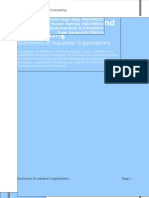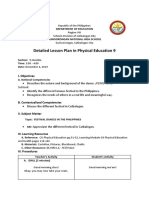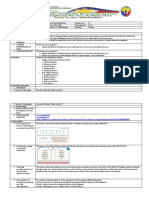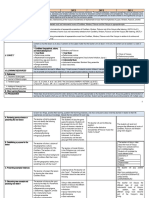Lesson Lesson Plan Selibio
Lesson Lesson Plan Selibio
Uploaded by
Kaye Cee SelibioCopyright:
Available Formats
Lesson Lesson Plan Selibio
Lesson Lesson Plan Selibio
Uploaded by
Kaye Cee SelibioCopyright
Available Formats
Share this document
Did you find this document useful?
Is this content inappropriate?
Copyright:
Available Formats
Lesson Lesson Plan Selibio
Lesson Lesson Plan Selibio
Uploaded by
Kaye Cee SelibioCopyright:
Available Formats
School WEST VISAYAS STATE Grade Level GRADE 9
UNIVERSIRTY (LA PAZ CAMPUS
DETAILED Learning Folkdance
Teacher KAYECEE B. SELIBIO
LESSON Area
PLAN . 2nd
Time & Dates Quarter
I. OBJECTIVES
Content Standard: Demonstrates understanding of guidelines and principles in exercise
program design to achieve personal fitness
Performance Standard: Describes the nature and background of the dance
Learning Executes the skills involved in the dance
Competencies/Objectives (Write PE7RDIIId-h-4
the LC Code for each): OHSP PE 1 Q 4 – module 1
II. CONTENT MEASUREMENT
III. LEARNING RESOURCES
A. References
1.Teacher’s Guide Pages TM pp: 100-102
2.Learner’s Materials Pages
3.Textbook Pages 21st Century Mathletes TX pp: 253-259
4.Additional Materials
5.Learning Resource
(LR) portal
B. Other Learning Ppt, Laptop, Smart T.V.
Resources
IV. PROCEDURES Teacher’s Activity Learner’s Activity
A. Reviewing or presenting ELICIT
the new lesson
-Good morning class. -Good morning Sir Selibio.
-Before we start our lesson for
today, everyone please stand for (everyone stand and pray)
our prayer.
-Thank you and settle down. (everyone went to their respective
seats)
A. DRILL
-Ok, now who can tell me what are (Lory) Panagbenga Festival.
(An(Ana) Giant Lantern Festival.
the different types of festivals here
in the Philippines? (Brett) Dinagyang Festival.
(Steffie) Pahiyas Festival.
(Hanah) Kadayawan Festival.
(Jellie) Higantes Festival.
(Samara) Pintados Festival
(Aiden) Masskara Festival.
B. REVIEW
In your previous lesson last week, we
discussed about the different types
Source: DepEd Order #42 s. 2016
of festivals here in the Philippines?.
-Ok class,do you know what is -Festival dances are cultural
festival? performances that bring together
communities, often in honor of a
patron saint or to celebrate a
-Very good, Ayah! bountiful harvest. These dances can
be religious or secular in nature and
involve various locomotor and non-
locomotor movements. Locomotor
movements include steps, walks, runs,
and jumps, while non-locomotor
movements occur in one place and
include flexion, extension,
contraction, release, collapse, recover,
rotation, twist, pivot, and turn.
Festivals benefit communities by
promoting unity and industry,
attracting tourists, and improving
physical health.
-Now, give me one example of -Dinagyang Festival is a religious
festival dances and its history. and cultural festival in Iloilo City,
Philippines, held annually on the
fourth Sunday of January in honor of
Santo Niño, the Holy Child. It is one of
the largest festivals in the Philippines,
drawing hundreds of thousands to
over a million visitors every year.
B. Establishing a purpose Motivation:
for the
lesson Who among you here loves to travel (All students raised their hands)
and witness the different folkdances Ditus: Me ma’am.
here in the Philippines? Lapay bantigue
What about joining some competition?
C. Presenting examples ENGAGE:
of the new lesson
Now our lesson for today is all about
History of Folkdance and basic steps in
Folkdance.
-Folk dance refers to a type of dance
What is Folkdance? that is a vernacular, usually recreational,
expression of a past or present culture.
It is a dance that reflects the life of the
people of a certain country or region.
Folk dances are not limited to
professional dancers and are often
performed by individuals with little or
no formal training. These dances are
typically accompanied by traditional
music and are deeply rooted in the
cultural heritage of a community.
Source: DepEd Order #42 s. 2016
What are the basic steps in folkdance? -Hopping,Chassé,Schottishe,STEP-HOP
D. Discussing new FIXING SKILLS:
concepts and practicing
new skills #1 1) What are the 5 fundamental positions 1) First Position: Form a V-shape with
of arms and feet in folkdance your feet by bringing your heels together
to touch while keeping your toes away
from each other. For the arms, raise them
into a circle in front of your chest with
slightly curved arms and fingertips at
least 1 inch apart.
2) Second Position: Move one foot
sideward, keeping your feet parallel to
each other with a distance of about 12
inches. Open your arms sideward at
shoulder level.
3) Third Position: Bring one foot’s heel to
touch the arch of the other foot, with
both feet turned outward. One arm is
raised above your head while the other
arm maintains the second position.
4) Fourth Position: Put one foot forward
while the other foot retains its position,
maintaining a distance of about 12 inches
between the two feet. The arm in the
second position is raised forward in front
of your chest again, similar to how it was
in the first position.
5) Fifth Position: Bring the heel of one
foot in front to touch the toe of the other
foot, both feet pointing outward. Both
arms should be lifted above your head,
slightly curving.
What is hopping in folkdance? -Hopping: Hopping is a fundamental and
energetic movement frequently used in
folk dance choreography. Different
cultures incorporate hopping in various
ways, such as alternating hops between
feet or repetitive hopping either in place
or while moving. Hopping adds
dynamism and flair to many folk dance
routines.
E. Discussing new
concepts and practicing Give me what is posistion is this Move
new skills #2 one foot sideward, keeping your feet
parallel to each other with a distance of
about 12 inches. Open your arms
sideward at shoulder level.
- Who can answer?
-Very good! Kyle: Me, Sir.
-second position
What are the basic steps in folkdance?
Source: DepEd Order #42 s. 2016
-Anyone volunteer?
-Good job!
Ralph: Sir.
-Hopping,Chassé,Schottishe,STEP-HOP
F. Developing Mastery (Group the learners into 2 groups)
GROUP WORK!
-Group 1 and 2 Create a dance using the
5 fundamental positions of arms and feet.
G. Finding Practical APPLICATION:
Applications of
concepts and skills in Now that you all know about our topic,
daily living let me ask you something.
1. What can you say about our culture in (Student answer)
the phillippines?
(Student answer)
2. What makes you learn in our
discussion?
H. Making GENERALIZATION:
Generalizations and What is folkdance? -The term “folk” in folk dance should
Abstractions about the indicate a certain kind of dance that is
lesson What is 5th position? performed by specific groups of people,
typically with cultural significance.
However, early scholars often used the
term with condescension, describing folk
communities as simple or quaint. They
believed that true folk dances were
ancient traditions passed down
anonymously.
6) -Fifth Position: Bring the heel of one
foot in front to touch the toe of the other
foot, both feet pointing outward. Both
arms should be lifted above your head,
slightly curving.
I. Evaluating Learning For individual work, get 1 whole sheet of
paper and write your own reaction
paper in our today’s discussion. Are we
clear? -Yes, ma’am.
J. Additional Activities for ASSIGNMENT:
Application or
Remediation Site some places in Iloilo and picture it
then put a explanation about their
culture. -Yes, ma’am.
So let it call a day. I hope that you’ve
learned a lot today.
(Ask someone to lead the prayer)
Source: DepEd Order #42 s. 2016
Thank you and goodbye, class! (praying)
Thank you and goodbye, ma’am!
V. REMARKS
VI. REFLECTION
A. No. of learners who earned 34 learners
80% in the evaluation
B. No. of learners who require 3 learners
additional activities for
remediation
C. Did the remedial lessons
work? No. of learners who
have caught up the lesson
D. No. of learners who
continue to require
remediation
E. Which of my teaching
strategies worked well?
Why did these work?
F. What difficulties did I
encounter which my
principal and supervisor
help me solve?
G. What innovation or
localized I used/discover
which I wish to share with
other teacher?
Prepared by:
KAYECEE B. SELIBIO
Noted:
NOEL PUZON MONDEJAR
Source: DepEd Order #42 s. 2016
You might also like
- Daily Lesson Log in P.E 9 3rdqDocument6 pagesDaily Lesson Log in P.E 9 3rdqVhannie Acquiatan86% (7)
- InvocationDocument3 pagesInvocationDavid Rojas100% (1)
- Sample Makemytrip Flight TicketDocument3 pagesSample Makemytrip Flight TicketShaishab DasNo ratings yet
- DLL Mapeh 3rd Quarter (P.e)Document4 pagesDLL Mapeh 3rd Quarter (P.e)FRANCISCA C. MARAVILLANo ratings yet
- Demand Estimation and ForecastingDocument30 pagesDemand Estimation and ForecastingShivraj Singh Negi75% (8)
- Cit 102 PDFDocument216 pagesCit 102 PDFKelechi Rowland Nwogbe100% (1)
- Pe9Pf Iiia H23Document7 pagesPe9Pf Iiia H23joanabe soretaNo ratings yet
- FESTIVAL IN THE PHILIPPINES (PE9RD-IIb-1)Document9 pagesFESTIVAL IN THE PHILIPPINES (PE9RD-IIb-1)Judy Ann MorilloNo ratings yet
- Final DemoDocument7 pagesFinal DemoAya Jamel AsoqueNo ratings yet
- LPE, Damas-WPS OfficeDocument8 pagesLPE, Damas-WPS OfficeCaren DamasNo ratings yet
- Lessonplan MAPEH 10Document2 pagesLessonplan MAPEH 10novelle palacioNo ratings yet
- Grade 7 Festival DanceDocument13 pagesGrade 7 Festival DanceDiana Lou LagaloNo ratings yet
- Physical Education Lesson Plan Q3 L2Document3 pagesPhysical Education Lesson Plan Q3 L220-1-01224No ratings yet
- 3rd Grading g9 Festival Dancing December 10 14Document6 pages3rd Grading g9 Festival Dancing December 10 14Gene Edrick CastroNo ratings yet
- Philippine Festival 2Document4 pagesPhilippine Festival 2Ma. Katrina CalangianNo ratings yet
- DLL Mapeh 3rd Quarter P eDocument4 pagesDLL Mapeh 3rd Quarter P eDawn Irad Millares100% (1)
- Pe 2 4TH QuarterDocument35 pagesPe 2 4TH QuarterEricson PandesNo ratings yet
- Lesson Plan DetailedDocument10 pagesLesson Plan DetailedDebby Bantug100% (1)
- April 3' 24 Fundamental SkillsDocument8 pagesApril 3' 24 Fundamental Skillsmarita castilloNo ratings yet
- DLLP PE9 March 27 31 2023 - Festival DanceDocument17 pagesDLLP PE9 March 27 31 2023 - Festival DanceAljun MansalapusNo ratings yet
- DATINGGALING-LESSON-PLAN-IN-PHYSICAL EDUCATION-Feb-22Document4 pagesDATINGGALING-LESSON-PLAN-IN-PHYSICAL EDUCATION-Feb-22Renier DatinggalingNo ratings yet
- Madarcos DLP MapehDocument10 pagesMadarcos DLP MapehCrisanto CabilloNo ratings yet
- Content Knowledge and PedagogyDocument19 pagesContent Knowledge and PedagogyErika LeonardoNo ratings yet
- Detailed Lesson Plan For Final Demo 3Document13 pagesDetailed Lesson Plan For Final Demo 3Jocelyn ChaveniaNo ratings yet
- Quarter 3Document10 pagesQuarter 3Isaiah Gib BagaNo ratings yet
- Detailed Lesson Plan in Physical Education 9 I. Objectives: College of Human KineticsDocument6 pagesDetailed Lesson Plan in Physical Education 9 I. Objectives: College of Human KineticsJaybee MacadangdangNo ratings yet
- Pe LPDocument3 pagesPe LPHazel Rubas SamsonNo ratings yet
- A Detailed Lesson Plan in Mapeh: I. ObjectivesDocument3 pagesA Detailed Lesson Plan in Mapeh: I. ObjectivesChichan S. SoretaNo ratings yet
- Mapeh DLL NovemberDocument8 pagesMapeh DLL NovemberGlenn RosalesNo ratings yet
- Music (3 4th)Document8 pagesMusic (3 4th)Janille RepullezaNo ratings yet
- g9 FestivalDocument7 pagesg9 FestivalKith DelcampoNo ratings yet
- Mapeh DLL NovemberDocument6 pagesMapeh DLL NovemberGlenn RosalesNo ratings yet
- Lesson Plan in Mapeh Grade 9Document5 pagesLesson Plan in Mapeh Grade 9Yasmin Da-anton UrayNo ratings yet
- S.Y. 2021 - 2022 Teacher's Name: Gilbert P. Obing Jr. Quarter: 1 Grade 12 Subject: P.E & HEALTH/Week 1 Teaching Date/Time: T-TH 10:30-11:30amDocument3 pagesS.Y. 2021 - 2022 Teacher's Name: Gilbert P. Obing Jr. Quarter: 1 Grade 12 Subject: P.E & HEALTH/Week 1 Teaching Date/Time: T-TH 10:30-11:30amGilbert ObingNo ratings yet
- GYMNASTICDocument9 pagesGYMNASTICJohnne Erika LarosaNo ratings yet
- DLL, December 03 - 06, 2018Document3 pagesDLL, December 03 - 06, 2018Malmon TabetsNo ratings yet
- Music 7.2Document6 pagesMusic 7.2MATEO CRISTINE IMEESHARENo ratings yet
- WEEK NO. 7 DAY 1 (Nature and Background of Festival Dances)Document2 pagesWEEK NO. 7 DAY 1 (Nature and Background of Festival Dances)Alfie SecretarioNo ratings yet
- DLP ARTS 4th QuarterDocument4 pagesDLP ARTS 4th QuarterJhac FamorNo ratings yet
- P.E. (Festival Dance)Document9 pagesP.E. (Festival Dance)Jaybee MacadangdangNo ratings yet
- Daily Lesson Log: School Year: 2022-2023Document4 pagesDaily Lesson Log: School Year: 2022-2023Kristela Mae ColomaNo ratings yet
- DLL G7-Q4-WEEK-1 Sy 2022-2023Document4 pagesDLL G7-Q4-WEEK-1 Sy 2022-2023RICHARD SAMPANANo ratings yet
- Grade 9 PE Module 2Document6 pagesGrade 9 PE Module 2fionakatebatitismoNo ratings yet
- DLL - March 11-15, 2024 - Labay, AveryDocument4 pagesDLL - March 11-15, 2024 - Labay, AveryAvery LabayNo ratings yet
- PE3 NotesDocument7 pagesPE3 NotesLeonel Joshua Precilla PaladanNo ratings yet
- BPEd LPE FormatFINALDocument1 pageBPEd LPE FormatFINALCaren DamasNo ratings yet
- Detailed Lesson Plan in PE Festival DanceDocument5 pagesDetailed Lesson Plan in PE Festival DanceKaren Anne Ramiscal RasosNo ratings yet
- Class Observation LPDocument6 pagesClass Observation LPLorbie Castañeda FrigillanoNo ratings yet
- Final DLP in MusicDocument8 pagesFinal DLP in MusicE Viv FuentesNo ratings yet
- Festival DancesDocument5 pagesFestival DancesCharlene DesoacidoNo ratings yet
- Music Dlp-Quarter 1, Week 1Document4 pagesMusic Dlp-Quarter 1, Week 1Annaliza EstebanNo ratings yet
- PE102Document6 pagesPE102Earl Longyapon FranciscoNo ratings yet
- Colegio de San Juan de Letran: Physical Education AreaDocument5 pagesColegio de San Juan de Letran: Physical Education AreaFrancis EnriquezNo ratings yet
- April 1 DLPDocument8 pagesApril 1 DLPmarita castilloNo ratings yet
- Lesson Plan New Bonie Co Q4Document10 pagesLesson Plan New Bonie Co Q4BONIFACIO ORGA100% (1)
- CPAR & HOPEDocument5 pagesCPAR & HOPEMarvin VersozaNo ratings yet
- DLL Q4 Music G7 Week 1Document4 pagesDLL Q4 Music G7 Week 1Hannalene DolorNo ratings yet
- Mapeh 7 LPDocument8 pagesMapeh 7 LPRey an MontanoNo ratings yet
- August 20 MusicDocument2 pagesAugust 20 MusicARVEE DAVE GIPANo ratings yet
- non religious (1)Document10 pagesnon religious (1)edwin mangahasNo ratings yet
- Metropolitan College of Science and TechnologyDocument15 pagesMetropolitan College of Science and TechnologyKevin AlibongNo ratings yet
- Third Quarter Lesson Plan-PeDocument4 pagesThird Quarter Lesson Plan-PeLeanTamsiNo ratings yet
- Lyrics of Friend of MineDocument1 pageLyrics of Friend of Minecayla mae carlosNo ratings yet
- Transformer OilDocument2 pagesTransformer OilvtechelectricNo ratings yet
- E2Tech Energy Forum ScheduleDocument2 pagesE2Tech Energy Forum Schedulegerald7783No ratings yet
- "Madrasah Ibtidaiyah Al-Uluhiyah": I. Choose The Correct Answer by Crossing (X) A, B, C, or D !Document3 pages"Madrasah Ibtidaiyah Al-Uluhiyah": I. Choose The Correct Answer by Crossing (X) A, B, C, or D !Ali AkbarNo ratings yet
- Theoretical Development in The Field of Human Resources Management: Issues and Challenges For The FutureDocument25 pagesTheoretical Development in The Field of Human Resources Management: Issues and Challenges For The FutureVijayibhave SharmaNo ratings yet
- Methodology For Performing Aircraft Impact Assessments For New Plant DesignsDocument69 pagesMethodology For Performing Aircraft Impact Assessments For New Plant DesignsdcdbgNo ratings yet
- Lecture 1: An Introduction To CUDA: Mike GilesDocument40 pagesLecture 1: An Introduction To CUDA: Mike Gilessdancer75No ratings yet
- (Advances in Intelligent Systems and Computing 456) Maria Brigida Ferraro, Paolo Giordani, Barbara Vantaggi, Marek Gagolewski, María Ángeles Gil, Przemysław Grzegorzewski, Olgierd Hryniewicz (Eds.)-SoDocument538 pages(Advances in Intelligent Systems and Computing 456) Maria Brigida Ferraro, Paolo Giordani, Barbara Vantaggi, Marek Gagolewski, María Ángeles Gil, Przemysław Grzegorzewski, Olgierd Hryniewicz (Eds.)-SoHernánQuirozNo ratings yet
- Daftar Harga Produk Pt. Pyridam (Divisi Ethical) Efektif: 01 NOVEMBER 2022Document12 pagesDaftar Harga Produk Pt. Pyridam (Divisi Ethical) Efektif: 01 NOVEMBER 2022KikkyNo ratings yet
- Phillips LED Retrofit LampsDocument10 pagesPhillips LED Retrofit LampsShivansh Singh GautamNo ratings yet
- Language in ContactDocument19 pagesLanguage in ContactEmma Sri Rahayu100% (1)
- Khutbah 11 Dec 09 - The Deen Is ClearDocument8 pagesKhutbah 11 Dec 09 - The Deen Is ClearRadamés Hakim H'eqalNo ratings yet
- School Form 1kjeidljeDocument4 pagesSchool Form 1kjeidljePrincess Rocella LinoNo ratings yet
- Waste Management Policy Brief ArDocument14 pagesWaste Management Policy Brief ArSONY GEORGE CHERIANNo ratings yet
- Dissertation Topics For Architecture StudentsDocument5 pagesDissertation Topics For Architecture StudentsOrderCustomPapersSiouxFalls100% (1)
- Dormitory Manager IV - Office of Student Housing - UPSB-DORMG4-27-1998Document2 pagesDormitory Manager IV - Office of Student Housing - UPSB-DORMG4-27-1998AANo ratings yet
- COURSERADocument1 pageCOURSERAIshu vermaNo ratings yet
- Teaching Medicine and Medical Ethics Using PopularDocument180 pagesTeaching Medicine and Medical Ethics Using PopularRizky AmaliahNo ratings yet
- PMP Credential Exam Preparation CourseDocument24 pagesPMP Credential Exam Preparation Coursesubin_mampallyNo ratings yet
- 4 Accident CausationDocument13 pages4 Accident Causation36. Yura tamaNo ratings yet
- Case Study Analysis - PhilipsDocument1 pageCase Study Analysis - PhilipsRohit MathurNo ratings yet
- French To English Translator in PyTorchDocument30 pagesFrench To English Translator in PyTorchDivyanshu NandwaniNo ratings yet
- Notes Applications of Molecular Techniques (Supplementation)Document5 pagesNotes Applications of Molecular Techniques (Supplementation)christineeraymundo02No ratings yet
- Publish United States Court of Appeals For The Tenth CircuitDocument14 pagesPublish United States Court of Appeals For The Tenth CircuitScribd Government DocsNo ratings yet
- Kcse 1999 Biology QuestionsDocument7 pagesKcse 1999 Biology QuestionsUrex ZNo ratings yet
- War of The Sicilian VespersDocument9 pagesWar of The Sicilian VespersNatalia ArmentaNo ratings yet

























































































